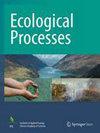Linkages among leaf nutrient concentration, resorption efficiency, litter decomposition and their stoichiometry to canopy nitrogen addition and understory removal in subtropical plantation
IF 3.9
2区 环境科学与生态学
Q1 ECOLOGY
引用次数: 0
Abstract
The prevalence of understory removal and anthropogenic nitrogen (N) deposition has significantly altered the ecological processes of forest ecosystems at both regional and global scales. However, it remains a pressing challenge to understand how N deposition and understory removal affect leaf nutrient dynamics, nutrient resorption, litter decomposition, and their linkages for better managing forest ecosystems under nutrient imbalances induced by N enrichment. To address this research gap, a field manipulation experiment was carried out in a subtropical Cunninghamia lanceolata plantation with four treatments including: control (CK), canopy N addition (CN), understory removal (UR), and canopy N addition plus understory removal (CN × UR). Green and senesced leaf N and phosphorus (P) concentrations, N and P resorption efficiencies, litter decomposition, and their correlations were measured. The results revealed that the average N concentrations of green early and late leaves in UR were increased by 6.61 and 18.89% compared to CK. UR had the highest whereas CN had the lowest P concentrations in green leaves across the two sampling seasons. Following this, UR, leaf type, season, and their interactions significantly affected leaf N, P, and N:P (P < 0.05). The highest leaf N resorption (32.68%) and P resorption efficiencies (63.96%) were recorded in UR. Litter decomposition was significantly retarded in UR (P < 0.01) relative to CN. The regression analysis demonstrated that leaf nutrient status was significantly interconnected with leaf nutrient resorption efficiencies. In addition, leaf nutrient dynamics were strongly correlated with litter nutrients, indicating that both were coupled. These findings can deepen our knowledge of biogeochemical cycling and reveal contrasting nutrient-acquisition strategies on N and P limitation in response to UR and CN. Considering the P limitation, it is important to note that P was resorbed more efficiently, illustrating a remarkable nutrient preservation approach for nutrient-limitations. Resorption may be a crucial mechanism for keeping nutrients in these forests, so better understory management practices are required to prevent reliance on external nutrient pools. Overall, this study sheds meaningful insights into the ability of forest adaptation in response to global climatic change.亚热带种植园中叶片养分浓度、吸收效率、枯落物分解及其与冠层氮添加和林下氮清除之间的化学计量关系
林下植物移除和人为氮(N)沉积的普遍存在极大地改变了区域和全球范围内森林生态系统的生态过程。然而,如何理解氮沉积和林下植物移除如何影响叶片养分动态、养分吸收、枯落物分解以及它们之间的联系,以便在氮富集导致养分失衡的情况下更好地管理森林生态系统,仍然是一项紧迫的挑战。针对这一研究空白,我们在亚热带杉木人工林中开展了一项田间操作实验,共设四个处理,包括对照(CK)、冠层氮添加(CN)、林下植物移除(UR)和冠层氮添加加林下植物移除(CN × UR)。对绿叶和衰老叶片的氮和磷浓度、氮和磷的重吸收效率、枯落物分解及其相关性进行了测定。结果表明,与 CK 相比,UR 早期和晚期绿叶的平均氮浓度分别增加了 6.61% 和 18.89%。在两个采样季中,UR 的绿叶中 P 浓度最高,而 CN 的 P 浓度最低。随后,UR、叶片类型、季节及其交互作用对叶片氮、磷和 N:P 有显著影响(P < 0.05)。UR 的叶片氮吸收率(32.68%)和磷吸收率(63.96%)最高。相对于 CN,UR 的腐叶分解速度明显较慢(P < 0.01)。回归分析表明,叶片养分状况与叶片养分重吸收效率密切相关。此外,叶片养分动态与枯落物养分密切相关,表明二者是耦合的。这些发现加深了我们对生物地球化学循环的认识,并揭示了UR和CN对氮和磷限制的不同养分获取策略。考虑到钾的限制,重要的是要注意到钾被更有效地吸收,这说明了在养分限制中一种显著的养分保存方法。吸收可能是这些森林保持养分的关键机制,因此需要更好的林下管理方法,以防止对外部养分池的依赖。总之,这项研究对森林适应全球气候变化的能力提出了有意义的见解。
本文章由计算机程序翻译,如有差异,请以英文原文为准。
求助全文
约1分钟内获得全文
求助全文
来源期刊

Ecological Processes
Environmental Science-Ecological Modeling
CiteScore
8.50
自引率
4.20%
发文量
64
审稿时长
13 weeks
期刊介绍:
Ecological Processes is an international, peer-reviewed, open access journal devoted to quality publications in ecological studies with a focus on the underlying processes responsible for the dynamics and functions of ecological systems at multiple spatial and temporal scales. The journal welcomes manuscripts on techniques, approaches, concepts, models, reviews, syntheses, short communications and applied research for advancing our knowledge and capability toward sustainability of ecosystems and the environment. Integrations of ecological and socio-economic processes are strongly encouraged.
 求助内容:
求助内容: 应助结果提醒方式:
应助结果提醒方式:


